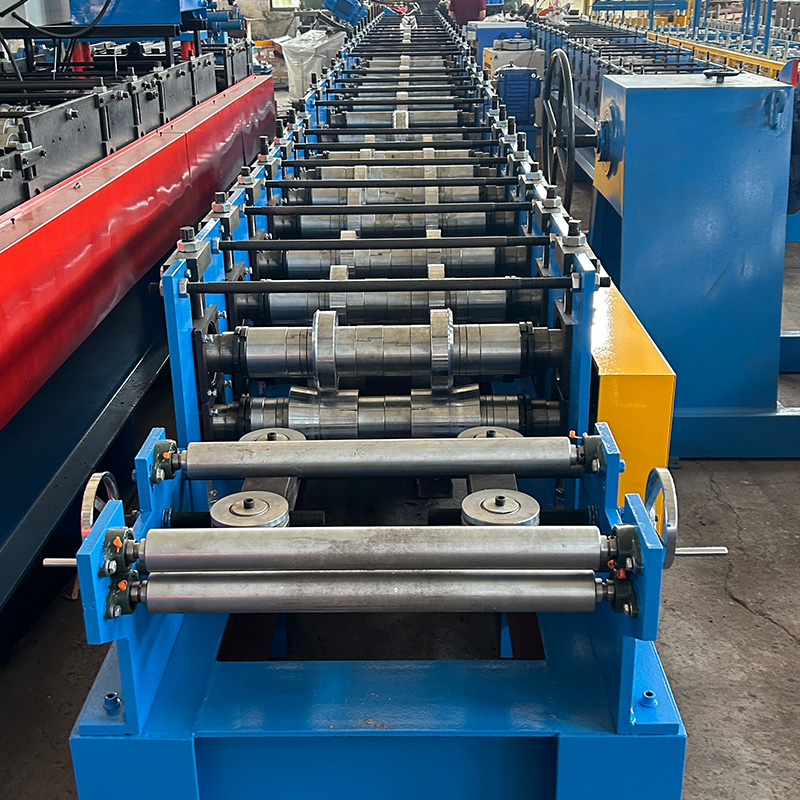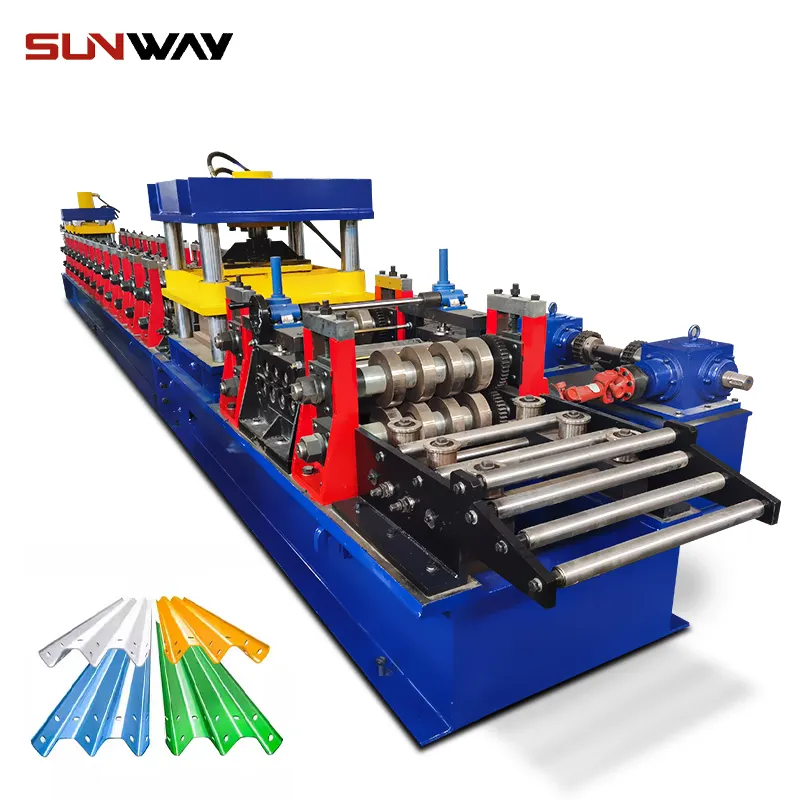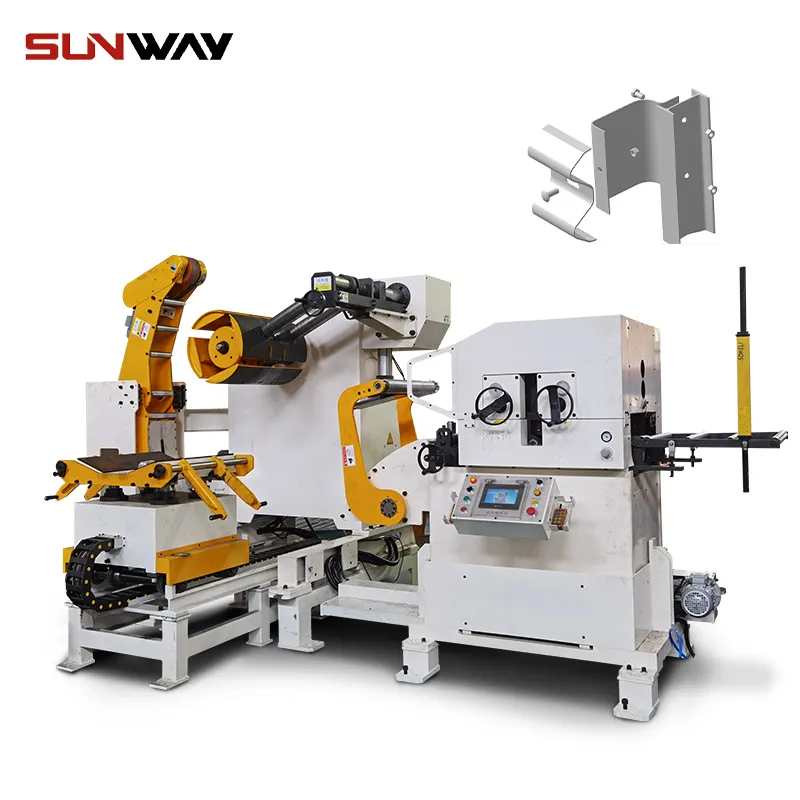Soffit roll forming machines are essential equipment for producing metal roofing panels, wall panels, drainage systems, and various other building products. This comprehensive guide provides a detailed overview of soffit roll formers covering their working, types, key specifications, applications, installation, operation, maintenance, suppliers, pricing, and more.
Overview of Soffit Roll Forming Machines
Soffit roll forming machines, also known as roll former lines, are designed to transform metal coils into customized panel profiles by passing them through consecutive forming stations. The forming stations progressively bend the strip to the desired cross-section profile.
Roll formed panels provide efficient, lightweight, and economic roofing and cladding options for modern construction. Roll forming lines produce panels in a continuous operation, yielding high throughput compared to other manufacturing processes.
The key advantages of using a soffit roll former include:
- Highly automated and efficient production of long panel lengths
- Ability to create complex and customized profiles
- Consistent quality and dimensional accuracy of panels
- Low tooling costs compared to other processes
- Minimal material waste
- Lower per-piece material and labor costs
- Flexible production volumes
Soffit roll forming enables companies to meet the growing demand for metal panels across residential, commercial, and industrial building markets.
How Do Soffit Roll Forming Machines Work?
The working principle involves uncoiling metal strip from a coil, passing it through a series of sequential forming stations with precision rollers, and progressively cold forming the strip into the desired panel profile.
The key components of a soffit roll former line include:
- Decoiler: Feeds the strip from a coil into the roll former
- Feeding mechanism: Pulls the strip stock through the roll forming stations at a suitable speed
- Forming stations: Bend the strip incrementally to the panel profile using rolling dies
- Punching unit: Punches holes if required for shifting panels
- Cutoff press: Cuts panels to specified lengths
- Supporting elements: Guide rails, strip loop control, devices etc.
The strip undergoes plastic deformation as it passes through each roller station without heating the material. The rolling dies only penetrate a small depth into the metal avoiding any material failure. Proper feed speed coordination with the different stations is critical for quality profile forming.
Soffit roll formers can typically process steel coils between 0.4 mm to 2 mm thickness, with widths up to 1250 mm. Line speeds range from 10 to 25 meters per minute depending on the profile.

Types of Soffit Roll Forming Machines
There are two main types of soffit roll forming equipment:
C-Type Soffit Roll Former
This is the most common type with C-shaped vertical forming stations arranged in a linear configuration. The strip passes horizontally from the decoiler through the stations in a straight line.
Advantages:
- Compact layout
- Lower cost
- Simpler material handling
- Easy to operate and maintain
Limitations:
- Limited profile capability
- Not suitable for high tonnage applications
O-Type Soffit Roll Former
In this design, the rolling dies are mounted in O-shaped stations, through which the strip passes vertically in a U-shaped path.
Advantages:
- Ability to produce more complex and higher strength panels
- Larger roll diameters provide higher bending power
- Better control over strip tension and thickness
Disadvantages:
- Requires more floor space
- Higher cost
- Material handling is more complex
Hybrid Type Roll Formers
Some advanced roll forming lines combine C and O type stations to get the best of both designs. Initial stations may be C-type for pre-bending while later stands are O-type for final profiling.
Key Specifications of Soffit Roll Forming Machines
The main parameters and specifications to consider while selecting a soffit roll former include:
Table 1: Key specifications of soffit roll forming machines
| Specifications | Typical Values |
|---|---|
| Production speed | 10 – 25 m/min |
| Metal thickness capacity | 0.4 – 2 mm |
| Strip width capacity | Up to 1250 mm |
| Min. final bending radius | 1-2 x metal thickness |
| Number of roller stations | 15 – 20 stands |
| Main drive power | 15 – 45 kW |
| Roller diameter | 150 – 250 mm |
| Roller adjustment | +/- 5 mm |
| Forming force per station | Up to 400 kN |
| Line height | 2000 – 2500 mm |
| Machine length | 15 – 25 m |
The production speed, strip dimensions, and line power need to be selected as per the required panel size, metal gauge, profile shape, and production volume.
Key Applications of Soffit Roll Forming Machines
Soffit roll forming lines allow efficient production of a wide variety of metal panels with specialized cross-sections. Typical applications include:
Table 2: Key applications of soffit roll forming machines
| उत्पादों | Description |
|---|---|
| Roofing panels | Trapezoidal, corrugated, box-rib, stepped etc. roofing profiles |
| Wall panels | Decorative, insulated, structural wall paneling |
| Flashings | For roofs, walls, parapets etc. |
| Solar panel frames | U-shaped profiles for solar PV arrays |
| Steel decking | For mezzanine floors, formwork etc. |
| Steel studs | C and U channel profiles as structural members |
| Metal roof tiles | Interlocking panels resembling clay tiles |
| Door panels | Profiled metal doors, partitions |
| Highway products | Noise barrier panels, rail coach panels etc. |
Advanced tooling designs allow roll forming lines to produce complex asymmetric and embossing type panel profiles too.

How to Design a Soffit Roll Forming Line?
Designing an efficient soffit roll forming system requires extensive engineering expertise. The key steps include:
- Evaluating product drawings and specifications
- Material selection and thickness optimization
- Determining process flow, number of stands, and type of stations
- Designing rolling dies and tooling for each station
- 3D modeling and simulation of the forming process
- Analysis of strip stresses using FEA software
- Designing machine frame, drives, and strip handling
- Integrating safety interlocks and controls
- Factory acceptance testing before shipment
The tooling design is critical to avoid defects like springback, twisting, and cracking in the finished panels. Proper forming sequence and die profiles must be developed based on material characteristics and product shape.
How to Choose A Suitable Soffit Roll Forming Machine Supplier?
With so many roll former manufacturers in the market, selecting a reliable supplier is vital for getting high-quality equipment. Here are key factors to consider:
Table 3: How to choose a suitable soffit roll forming machine supplier
| पैरामीटर | What to Look For |
|---|---|
| Technical expertise | Extensive know-how in roll tooling design, process engineering |
| अनुभव | Proven track record of previously executed projects |
| Production facilities | Modern plant, machining centers, quality control |
| अनुकूलन | Capability for specialized tooling and line design |
| Roll design | Latest 3D modeling and FEA simulation technology |
| After-sales service | Installation support, operator training, maintenance contracts |
| Certifications | ISO 9001 and other international quality standards |
| Customer reviews | Feedback on previous roll forming projects |
| Line trials | Availability of rental trial before purchase |
Reputable manufacturers who offer customized engineering, quality equipment, and reliable after-sales service should be preferred. Site visits and reference checks are advisable.
Soffit Roll Forming Machine Prices
Roll former prices vary significantly depending on the production speed, line width, number of stations, type of tooling, and level of automation. Typical price ranges are:
Table 4: Price range of soffit roll forming machines
| Specifications | Price Range |
|---|---|
| Max. Width: 1000 mm <br> Speed: 15 m/min | $40,000 – $60,000 |
| Max. Width: 1250 mm <br> Speed: 18 m/min | $55,000 – $80,000 |
| Max Width: 1500 mm <br> Speed: 25 m/min | $75,000 – $120,000 |
| Max Width: 1500 mm <br> Speed: 40 m/min | $150,000 – $250,000 |
Larger O-type roll formers with high tonnage capacities and production speeds can cost over $300,000. Complex tooling, decoilers, cutoff systems, and automation features increase the overall line cost.
How to Install a Soffit Roll Forming Machine?
Proper installation is vital for smooth functioning of a roll forming line. Here are some key guidelines:
- Prepare the foundation and flooring to handle machine loads
- Ensure sufficient room for safe operator movement around the line
- Lifting and positioning of machines using cranes/forklifts
- Mounting and alignment of machines on foundation
- Assembly and alignment of roll tooling in stations
- Installation of strip feeding and guiding equipment
- Connection of hydraulic, electric, and control panels
- Integration with decoiler, shear, stacker etc.
- Trial runs to confirm profile quality before full production
The supplier should provide an installation manual covering step-by-step procedures, safety precautions, and inspection checklists.
How to Operate a Soffit Roll Forming Line?
Trained operators are critical for safe and optimal operation of roll formers. Key operating guidelines include:
- Understanding the forming process, line speed coordination
- Operating the decoiler, feeder, punch, and cutoff press
- Monitoring strip alignment at each station
- Inspecting quality of formed panels
- Optimizing process parameters to reduce defects
- Proper handling and stacking of finished panels
- Following standard safety procedures
- Periodic roll maintenance and adjustment
- Reporting any abnormal noise, vibration or malfunction
- Recording production data for analysis
The supplier provides operating manuals for the entire line detailing start-up, shutdown, troubleshooting, maintenance, safety procedures.
Maintenance Guidelines for Soffit Roll Forming Machines
To maximize uptime and prolong equipment life, regular preventive maintenance of roll formers is essential covering:
Daily:
- Cleaning strip debris and dust
- Checking lubrication levels
- Inspecting filter elements
- Monitoring oil leaks, temperature
Weekly:
- Tightening loose parts and fasteners
- Checking belt tension and alignment
- Inspecting roll conditions and clearances
Monthly:
- Greasing bearings and sliding surfaces
- Hydraulic oil inspection
- Replacing worn rollers/bearings
- Functional testing of interlocks and brakes
Yearly:
- Gearbox oil changes
- Replacement of hydraulic hoses
- Electrical wiring inspection
- Alignment checks, calibration
- Roll grinding or hard-facing
The supplier’s service manual provides detailed preventive maintenance schedules and procedures.
How to Select the Right Soffit Roll Forming Machine?
Selecting the optimal soffit roll former involves consideration of key factors:
Table 5: How to select the right soffit roll forming machine
| पैरामीटर | Guidance |
|---|---|
| Product design | Evaluate panel size, shape, gauge, strength needs |
| Production volume | Determine monthly/yearly quantity for capacity planning |
| Line speed | High speeds up to 25 m/min for high volumes |
| Width capacity | Max. coil width based on product dimensions |
| Number of stations | More stations needed for complex profiles |
| Tooling material | Durable materials like D2 steel for long life |
| Automation needs | Decoiler, stacker, conveyors to reduce labor |
| Line monitoring | SCADA for production data monitoring |
| After-sales support | Installation, training, maintenance contracts |
| Budget | Compare pricing of different suppliers |
Consider both current and future production needs during selection. Partnering with an expert supplier is advisable for getting the optimal roll forming solution.

Pros and Cons of Soffit Roll Forming Machines
Advantages
- Highly efficient continuous production
- Ability to create complex custom profiles
- Consistent and superior product quality
- Low operating costs per panel
- Just-in-time production possible
- Minimal material wastage
- Fast changeovers between profiles
- Compact equipment footprint
Limitations
- High initial investment cost
- Careful tooling design required
- Qualified operators needed
- Regular roll maintenance required
- Limited to softer metals like steel, aluminum
- Not ideal for low volume production
FAQs
Q: What thickness of metal sheet can be roll formed?
A: Most roll formers can process metal coils between 0.4 mm to 2 mm thickness. Some heavy-duty machines can form up to 3 mm thick strips.
Q: How long does a roll forming machine last?
A: With proper maintenance and operation, the lifespan of a roll former is typically 15-20 years or more. The longevity depends on usage, maintenance quality, and environmental conditions.
Q: What safety aspects should be considered?
A: Key safety features include emergency stop buttons, light curtains at entry and exit, guarding for pinch points, interlocks on doors, roll maintenance locks, and operator training.
Q: How quickly can roll tooling be changed over?
A: On well-designed roll formers, the changeover time for replacing roll tooling is usually 1-3 hours. Quick change tooling minimizes downtime between different profile runs.
Q: Can a roll former make tapered rectangular profiles?
A: Yes, by adjusting the edge rollers independently, a rectangular profile with varying width along the length can be produced. Special guides are used to prevent strip wandering.
Q: What should be the surface finish of roll formed panels?
A: Roll formed parts typically have an as-fabricated finish suitable for further downstream processes like painting or lamination. Critical faces can be brush finished if needed.
Q: How to correct twisting of panels in roll forming?
A: Twisting can be minimized by using anti-twist guides between stands, adjusting roll pressures, straightening units, reducing feed rate, and modifying the forming sequence.
Q: What safety precautions are required during roll maintenance?
A: Recommended practices include electrical lockouts, machine isolation, blocking raised parts, releasing stored energy, avoiding accidental starts, proper lighting, and using the right tools.
निष्कर्ष
Soffit roll forming lines provide a versatile and economical means of producing long lengths of custom metal panel profiles. With an optimized forming design and robust equipment, high quality panels can be manufactured efficiently. Partnering with a knowledgeable roll forming machine supplier and investing in regular maintenance is key for maximizing performance. This guide covers the vital factors to consider when purchasing, installing, operating, and maintaining soffit roll formers.


